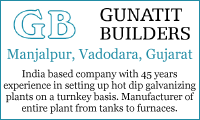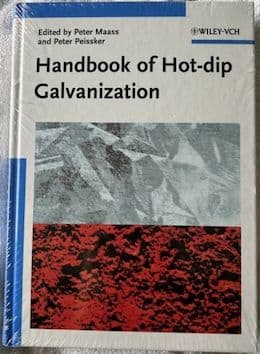
-----
Galvanizing Pot Temperature -- Ideal zinc temperature for galvanizing?
Q. Sir, I am facing a huge problem to set zinc melted temperature for galvanizing. How much temperature should be there for zinc according to you for hot dip galvanizing?
Manish Guptashop - Delhi, India
April 8, 2009
May 6, 2009
A. Sir,
Most North American galvanizers use about 840 °F [ed. note: 449 °C] for hot dip galvanizing. This can vary depending on a number of things.
Regards,
Galvanizing Consultant - Hot Springs, South Dakota, USA
May 8, 2009
A. In Europe, 450 °C [842 °F] seems to be the average, but I've seen as low as 440 and up to 460.
Of course at these temperatures the precision of the instrument should not be overlooked. Is 450 indicated exactly 450?

Geoff Crowley
Crithwood Ltd.
Westfield, Scotland, UK

Multiple threads merged: please forgive chronology errors and repetition 🙂
Q. Dear Sir,
Please tell me why we maintain pot temperature 460 °C only? what happens if I increase or decrease pot temperature?
Steel Employee - Ras-Al-Khaimah, U.A.E.
January 20, 2011
|
January 20, 2011 A. Dear Sir, - Selangor, Malaysia January 21, 2011 A. Dear Prashant. Gunatit Builders Manjalpur, Vadodara, Gujarat  |
A. Dear Sir,
The recommendations in my previous post is for General Galvanizing. Temp recommendation for Continuous Line will be different.
Regards,
- Selangor, Malaysia
January 21, 2011
A. For a steel kettle the temp is likely to be set at 450 °C ± 5. (445-455). Much higher than this (>460) and your kettle life will be dramatically reduced. You should expect approx. 10 years or 100,000 tonnes from a kettle. If you ran your zinc in a steel kettle at say 470 °C, you might half the life, 500 °C it might do well to last a few weeks!
Zinc melting point is 419 °C. You need enough heat to heat the steel (don't want to immerse a load and freeze the whole kettle), and to retain some fluidity on withdrawal.
Ceramic kettles are required for higher temperatures.
But in all this remember to take account of the accuracy of your measuring system. If it say ± 1%, then a reading of 450 °C might really be between 445 and 455 °C.

Geoff Crowley
Crithwood Ltd.
Westfield, Scotland, UK

January 25, 2011
Q. Dear Sirs,
In the standard, EN ISO 10684: Fasteners-Hot dip galvanized coatings.
Its stated in p5.5 that "galvanizing shall not be carried out at bath temperatures between 408^480 and 530 °C".
Why? What happens to the steel?
Kind regards,
- Sweden
September 28, 2017
A. Firstly the melting point of zinc is about 419 °C, so clearly to immerse steel in zinc the temperature must be higher than that. In practice not many operate at less that about 435 °C.
Galvanizing isn't just a dip coating, rather its an alloying reaction. An alloy (a mixture of zinc and iron) forms on the surface of the steel. The rate the alloy forms is dependent on several factors, but primarily the chemistry of the steel (especially Si and P), and the temperature of the zinc.
Hotter = faster generally, but it's not linear. There's a spike of reactivity at about 530 °C where the reaction takes place several times faster.
Now from that you might think speed is good, but consider this.. The zinc must be contained in something. That is a steel tank, externally heated. And that tank is also reacting with the zinc, forming alloy, and that consumes the steel tank slowly.
So at 530 °C, a tank that starts at 50 mm thick might last a few weeks until it's too thin to be safe (perhaps 25 mm). But at 450 °C it should last 12 years or 120,000 tonnes processed whichever comes first.
So, while the standard allows for a wide variation in temperatures, practical considerations mean a more likely range of 440-460 °C.
It is possible to contain zinc in a ceramic tank, but heating the zinc is a lot less efficient both is terms of energy consumption, and in oxidation losses of the zinc, so that method is rare now, and becoming more rare.

Geoff Crowley
Crithwood Ltd.
Westfield, Scotland, UK

October 1, 2017
October 3, 2017
Q. Hi Geoff,
Thanks for your answer.
I noticed that I wrote wrong figures in the text, I mean temperatures between 480-530 °C.
We galvanize in both low and high temperature, and we are aware of what "wrong" temperature can do to the steel so we use both ceramic and steel kettle.
But why does the standard warn us for galvanize in that temperature range?
Over 480 the zinc becomes very reactive/aggressive to the steel in the kettle, but that can't be the reason for the warnings?
There must be some other disadvantage buy doing that? or ??
kind regards,
ulf
- Sweden, Sweden
A. A very late response to the question.
I am not exactly sure why the standard warns about temp, but a guess is that its a warning of very variable and unpredictable outcomes.
A standard tries to get a uniform outcome. Any encouragement to use conditions that result in variability isn't a good outcome.

Geoff Crowley
Crithwood Ltd.
Westfield, Scotland, UK

August 15, 2018
Q. Our strip entry temperature sometimes becomes 500 °C at zinc pot. At that time our galvanised surface becomes whitish generally in thicker gauges. WHY?
Pritam BahadurSAIL/BOKARO STEEL PLANT - BOKARO STEEL CITY
June 15, 2018
A. The reactivity between zinc and steel increases with temperature. Get the steel too hot and you get thicker coating.

Geoff Crowley
Crithwood Ltd.
Westfield, Scotland, UK

August 22, 2018
Q. Our zinc kettle provider has set a limit of the operating temperature up to 460 °C. Why is that, and also is it recommended that the operating temperature of the kettle should be kept below 460 °C? Can someone explain this.
adnaan MalakGalvanizing - Abu Dhabi
July 13, 2019
Q, A, or Comment on THIS thread -or- Start a NEW Thread
